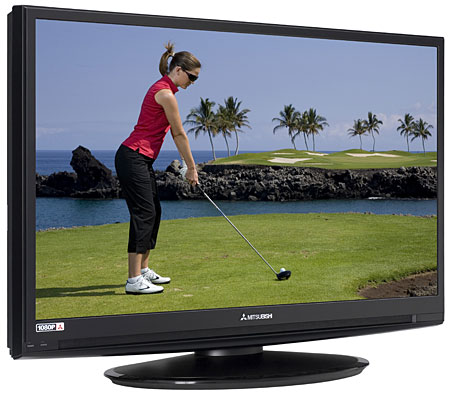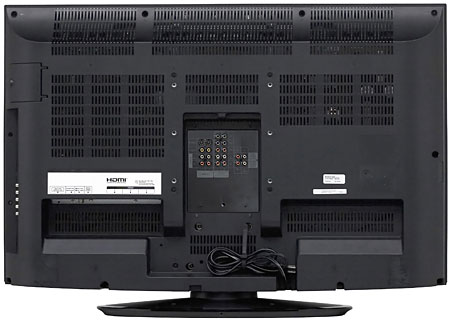Mitsubishi LT-46144 LCD Flat Panel HDTV

Mitsubishi's new LT-46144 ($3,699), at 46 inches, is one of the higher-end sets in the Mitsubishi lineup of flat panels. (The LT-46244 adds a slightly more generous set of inputs, a CableCARD slot, and a few other features). Not surprisingly, it's a 1920x1080p design. 1080p so dominates today's market in larger sets that most manufacturers don't even bother to mention it on the front page of their owner's manuals.
But there's more to this set than its now nearly universal 1080p resolution.
Description
The Mitsubishi's physical design doesn't stand out in any particular way. It has a swivel base that allows for a 30-degree offset to either side. Its flat black frame is thinner than most on the top and sides, but wider at the bottom to accommodate the thin slot where the sound exits.
I'll say no more about that sound except to mention that it's one of the set's weaker links, with a very obvious, canned coloration that makes people sound like they have serious head colds. Plan on an external sound system for any serious listening.
A major feature here, and one that's starting to show up on more and more sets, particularly flat panel LCDs, is 120Hz operation. Mitsubishi calls this "Smooth120Hz," and it's available only on the company's 144- and 244-series sets. It doubles video's standard 60Hz frame rate to 120Hz, which is claimed to produce less motion blur (a particular weakness of LCD flat panel displays). The added frame is not simply repeated, but interpolated using a Mitsubishi-developed algorithm.
The set will also accept and display a 1080p/24 source, such ad Blu-ray or HD DVD. However, rather than the optimum technique of upconverting 1080p/24 to 1080p/120 directly, to match the native 120Hz frame rate of the set, 1080p/24 inputs are first converted to 1080p/60 by adding 3/2 pulldown. The set then handles the signal as it would any 1080p/60 input by frame-doubling it to1080p/120.
The set's HDMI inputs are all HDMI 1.3. While Mitsubishi states that these inputs are therefore "compatible with" the Deep Color and x.v.Color features of HDMI 1.3, it's not possible at present to confirm how well the set will make use of these. There is no commercially available program material with those features at present, apart from the outputs of a few camcorders. For a number of reasons we've discussed elsewhere, don't expect movie releases to make use of these advanced color formats any time soon. Video games? Perhaps, but not yet.

The LT-46144 also supports Mitsubishi's NetCommand, which "seamlessly integrates selected older A/V products with new and future digital products." The set also supports NetCommand for HDMI, which expands this function to operate through the HDMI link for devices that are interconnected via HDMI. But the qualifier here is that it depends on the devices, as emphasized by the terms that appear in Mitsubishi's discussion of this feature, including "some newer" as well as "selected older A/V products," and "compatible devices". Most manufacturers offer similar HDMI interoperability under various names, and the same limitations will apply to them as well. I did not test either the vanilla or HDMI versions of NetCommand for this review.
The back panel has two numbered video inputs, each of them equipped with composite, S-Video, and composite connections and a single set of L/R analog audio inputs. These inputs, Input 1 and Input 2, are shared, meaning that although they each have multiple video jacks, only one type of source may be connected to either of them at any one time.
The back also has three HDMI 1.3 inputs. There's also a single set of L/R audio inputs to serve any HDMI jack used with a source that does not provide audio over the HDMI link (most commonly this means a device with a DVI output, including a computer, connected to the set via a DVI-to-HDMI adapter cable). There are also two antenna inputs, coaxial digital and L/R analog audio outputs to feed sound from the set's onboard ATSC and NTSC digital tuners to your outboard sound system, and an IR emitter for use with the NetCommand feature.
There is no CableCARD slot here, nor any PIP or POP. This is the third set I've reviewed recently that lacks both of these features. I smell a trend.
A side panel contains an additional component input with L/R audio, plus a USB port that can be used to view JPEG images.
- Log in or register to post comments



































































